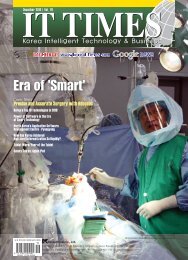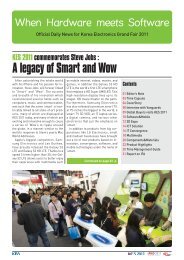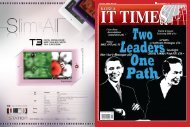Konkuk University Medical Center and its ... - Korea IT Times
Konkuk University Medical Center and its ... - Korea IT Times
Konkuk University Medical Center and its ... - Korea IT Times
Create successful ePaper yourself
Turn your PDF publications into a flip-book with our unique Google optimized e-Paper software.
iSEDEX2010<br />
30 Nano 2Gb DDR3 DRAM<br />
Samsung unveiled <strong>its</strong> 512GB SSD<br />
(Double Data Rate 3) DRAM chips," a company spokesman<br />
said. "Our 30nano-class process technology will provide the most<br />
advanced low-power DDR3 available today <strong>and</strong> therein the most<br />
efficient DRAM solutions anywhere for the introduction of consumer<br />
electronics devices <strong>and</strong> server systems," said the<br />
spokesman. "The new product will lower power consumption to<br />
85 percent of existing 40-nanometer DRAM chips. A nanometer<br />
is one-billionth of a meter. Along with this, the technology will also<br />
improve productivity by as much as 60 percent, as each<br />
DRAM chip will take up a smaller space on the production line,"<br />
he said. DRAM is a type of memory that stores data in a separate<br />
electronic component within a circuit. Based on the new nano<br />
technology, DDR3, which is emerging as the predominant main<br />
DRAM memory this year, is expected to be used in a broader<br />
range of products, from servers to notebooks, desktops, <strong>and</strong> future<br />
versions of Netbooks <strong>and</strong> mobile devices, the Samsung<br />
spokesman said.<br />
Introduction of 512GB SSD<br />
products<br />
Samsung, the world leader in advanced<br />
semiconductor technology solutions, introduced<br />
the first solid state drive (SSD)<br />
utilizing high-performance toggle-mode<br />
DDR NAND for mass production in<br />
June. The new 512 gigabyte (GB) SSD<br />
provides electronic data processing application<br />
designers with advanced performance<br />
<strong>and</strong> reliability for notebooks with<br />
premium value. "The highly advanced<br />
features <strong>and</strong> characteristics of our new<br />
SSD were obtained as a direct result of an<br />
aggressive push for further development<br />
of our NAND flash technology, our SSD<br />
controller <strong>and</strong> our supportive SSD<br />
firmware," the spokesman said.<br />
"Early introduction of this state-of-theart<br />
toggle DDR solution will enable<br />
Samsung to play a major role in securing<br />
faster market acceptance of the new wave<br />
of high-end SSD technology," he added.<br />
The new 512GB SSD makes use of a 30<br />
nanometer-class 32 gigabit chip that the<br />
company began producing last<br />
November. The toggle-mode DDR structure<br />
together with the SATA 3.0Gbps interface<br />
generates a maximum sequential<br />
read speed of 250 Megabyte per second<br />
(MBps) <strong>and</strong> a 220MBps sequential write<br />
speed, both of which provide three-fold<br />
the performance of a typical hard disk drive,<br />
he explained. "At these speeds, two st<strong>and</strong>ard length DVD<br />
movies (approximately 4GB each) can be stored in just a minute,"<br />
said the spokesman. Samsung provides further gains in power efficiency<br />
by having developed a low-power controller specifically<br />
for toggle-mode DDR NAND. The resulting power throttling capability<br />
enables the drive's high-performance levels without any<br />
increase in power consumption over a 40nm-class 16Gb NANDbased<br />
256GB SSD. Meanwhile, Samsung produced the industry's<br />
first multi-chip package (MCP) with phase-change RAM<br />
(PRAM) for use in mobile phones.<br />
The 512-megabit (512Mb) PRAM in the MCP is backward<br />
compatible with 40nm-class NOR flash memory in both <strong>its</strong> hardware<br />
<strong>and</strong> software functionality, providing h<strong>and</strong>set designers the<br />
convenience of having multi-chip packaging fully compatible<br />
with past st<strong>and</strong>-alone PRAM chip technology, the spokesman<br />
said.<br />
Kim Seungo-o/ k0357@koreaittimes.com<br />
www.koreaittimes.com 73
















